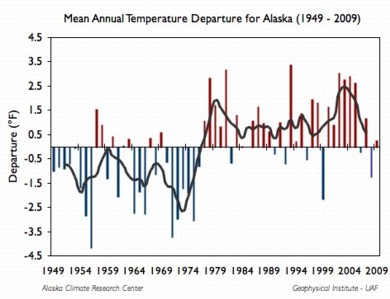Since the mid-1970s, Alaska has warmed at three times the rate of the Lower 48 states, according to the U.S. Environmental Protection Agency. And with nearly two-thirds of U.S. national parkland located in Alaska, the issue of climate change is especially pressing there, officials say.
In some far northern parks such as Gates of the Arctic, average temperatures are expected to shift in coming years from below freezing to above freezing, crossing a crucial threshold, said Bob Winfree, Alaska science adviser for the Park Service.
“The effects of melting ice and thawing permafrost, I think, will be major,” Winfree said.
http://uk.reuters.com/article/2011/02/12/us-alaska-climate-idUKTRE71B23320110212
In the business world, this would be known as “fraud.” At the EPA, it is known as business as usual.
All of the warming occurred in 1977, with the PDO shift.
Considering just a linear trend can mask some important variability characteristics in the time series. The figure at right shows clearly that this trend is non-linear: a linear trend might have been expected from the fairly steady observed increase of CO2 during this time period. The figure shows the temperature departure from the long-term mean (1949-2009) for all stations. It can be seen that there are large variations from year to year and the 5-year moving average demonstrates large increase in 1976. The period 1949 to 1975 was substantially colder than the period from 1977 to 2009, however since 1977 little additional warming has occurred in Alaska with the exception of Barrow and a few other locations
http://climate.gi.alaska.edu/ClimTrends/Change/TempChange.html



http://www.chicagotribune.com/news/chi-ap-oh-midwestfrostquake,0,5406473.story
Frost quakes LOL!!!
http://chronicle.northcoastnow.com/2011/02/11/frost-quakes-felt-in-western-ohio-experts-say/
Since the mid-1970s,…
I’m on to their game!
The retreat of Exit Glacier, one of the park’s best-known features, has forced park managers to reroute trails through areas that were under ice just a few years ago. The glacier’s retreat also has left a sheltered pavilion that was built in the 1990s far from the spectacular views of blue ice.
“We used to build these things with a sense of permanence,” said Jeff Mow, the park’s superintendent.
The only sense of permanence one can have regarding glaciers is that they are in a constant cycle of receding and advancing. There was a time when every school child learned that coastlines, rivers, mountains & climates all change.